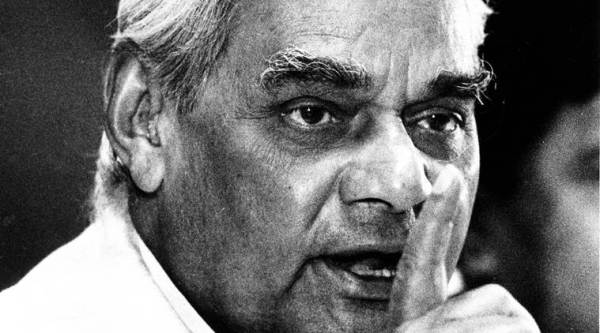A delicate truth
Espionage is an unending game, says Vikram Sood, but policymakers treat intelligence assessments like instant coffee

Under PM Atal Bihari Vajpayee, the R&AW recovered some ground. (Express Photo/Mahendra Parikh)
Title: The Unending Game: A Former R&AW Chief’s Insights into Espionage
Author: Vikram Sood
Publisher: Penguin Viking
Pages: 304
Price: Rs 599
Author: Vikram Sood
Publisher: Penguin Viking
Pages: 304
Price: Rs 599
After the Official Secrets Act (OSA) was invoked against Major General (retd) V K Singh, a senior official of the Research & Analysis Wing, for disclosing secrets in his book a decade ago, aspiring authors from the agency have been forced to be more circumspect. Some, like former Special Secretary Amar Bhushan have chosen the fictionalised route to describe clandestine operations of the Research and Analysis Wing (R&AW). We now have a major treatise from Vikram Sood, who headed R&AW in 2000-2003. Instead of revealing hitherto untold details about the agencies’ functioning, he has given us a broad sweep of worldwide espionage trends and the functioning of a phalanx of agencies, along with a bold critique of spectacular intelligence failures, including those which made possible the 9/11 attacks.
Sood calls intelligence agencies the “sword arm of the nation (not the government)” and clearly states that in India, there was a lack of appreciation for this role for agencies like the R&AW for furthering foreign security interests and protection. In the greater part of the book, the author describes the fierce if not obsessive rivalry between agencies like the America CIA and Russian KGB in the Cold War years. Espionage in the 21st century is a continuation of the Cold War years, he writes, “which had divided the world into two hostile ideological camps, both seeking world domination.”

In this environment, the ex-R&AW Chief writes, India inevitably became the playground for intelligence games between the CIA and the KGB. A very revealing passage from the book: “The game of suborning important Indian entities had begun early and by the 1960s, the KGB had acquired a considerable hold of the Indian system. This was classic intelligence business with Indira Gandhi’s code name being VANO in KGB records… Surely, the CIA would not have lagged behind in this kind of activity… the CIA’s assessment of that time was that the Soviets gave substantial financial assistance to Indira Gandhi’s Congress(I), the two Communist parties and individual politicians of different political parties…” The recruitment of the Larkin brothers in the 1980s, and, later, of R&AW official Rabinder Singh are among the instances of “successful” American infiltration mentioned in the book.
Hidden between accounts of the machinations of celebrated espionage agents and, much later, in the description of the deleterious effects of the cyber-adventures of Julian Assange and Edward Snowden, one discovers the import of Sood’s book — that policymakers mostly ignore long-term intelligence assessments and prefer, as he puts it, “shotgun or instant coffee reports.”
Coming from a former R&AW chief who spent over three decades in the external intelligence agency, there is this message for Indian policymakers: “People get the government they deserve and a government gets the intelligence it deserves…” Sood lists the five occasions when Pakistan has sent in soldiers masquerading as freedom fighters (the last being the 26/11 Mumbai attack) to stymie India and evidently, his message for the Indian leadership is this: “Kashmir continues to be troubled. We cannot indulge in glib talk about fighting terror jointly with Pakistan. It is like investigating a murder with the help of the murderer.”
To take the critique further, the trials and tribulations of the R&AW are chronicled though the changes in India’s political leadership. The agency was set up in 1968 during Indira Gandhi’s first tenure, and she is described as its “patron saint.” Her fortunes plummeted after the 1975 Emergency and once she lost elections, her successor Morarji Desai went about “systematically decimating the organisation.” He ordered the closure of stations, surrendered unfilled posts, shut down sensitive operations and slashed budgets. RN Kao, the legendary founder of the agency, resigned, and there was turmoil.
Indira Gandhi, Sood says, was never the same after she returned to power in 1981. She was politically weakened, and, eventually, lost her life to the violent politics of Punjab. The agency saw a “brief revival of fortunes with Rajiv Gandhi” but he, too, got diverted after the Bofors controversy and as the nation witnessed the political fallout of his Sri Lanka policy. The period from the prime ministership of VP Singh onwards is described as a “lost decade” for the R&AW, which saw a change of guard at the top at least nine times. This happened at a time when the ISI had mounted a vicious terror campaign in Jammu and Kashmir.
It was only during the tenure of Prime Minister Atal Bihari Vajpayee that the agency “recovered some ground”, but the Kargil misadventure and the IC-814 hijack followed. In the description of the aftermath of the two events, the author makes it clear that it was the politicians of the day who, in the first instance, disregarded intelligence and military alerts and in the second, succumbed to the pressure of the electronic media.
The author minces no words as he sums up, “Political leaders have a tendency to reject intelligence that does not suit their narrative and is therefore unpalatable. Their hearing becomes selective and the danger then is that intelligence agencies begin to politicise their inputs, as happened in the Second World War.” And again, “When an incident tales place, intelligence agencies become useful whipping boys for politicians and others as they assess their political fortunes…”





















No hay comentarios:
Publicar un comentario